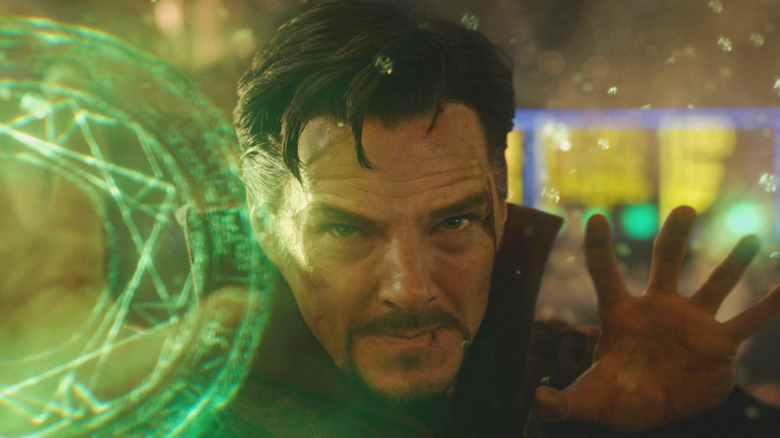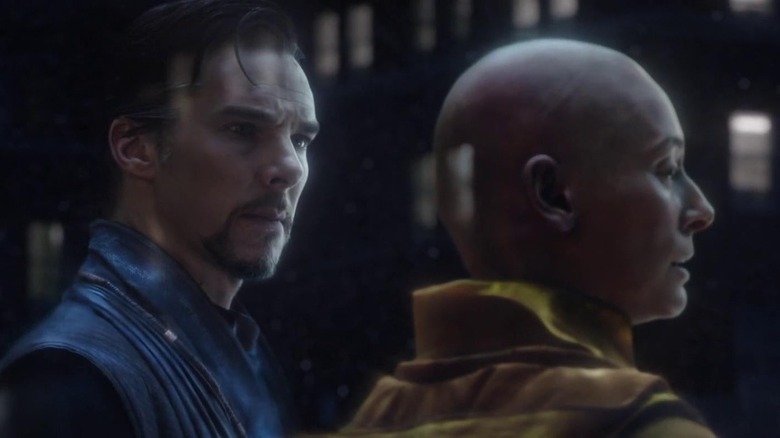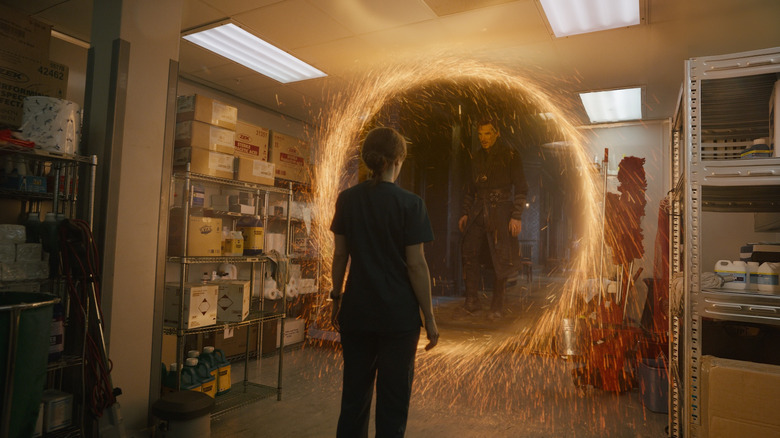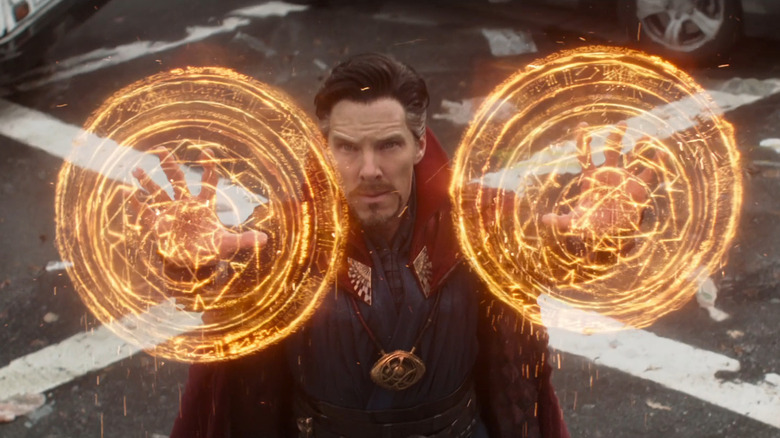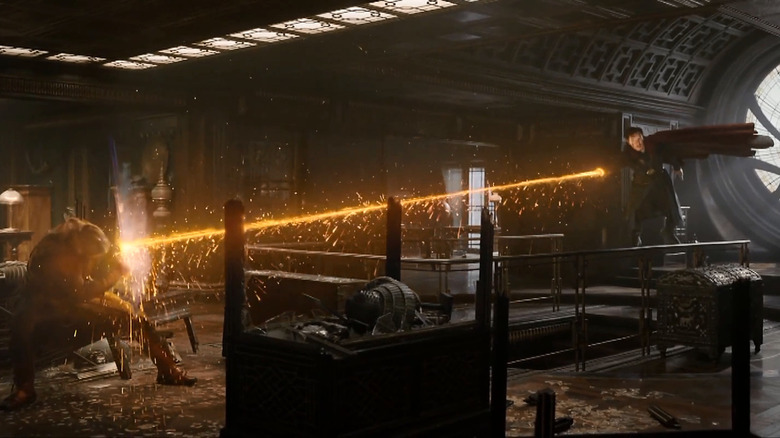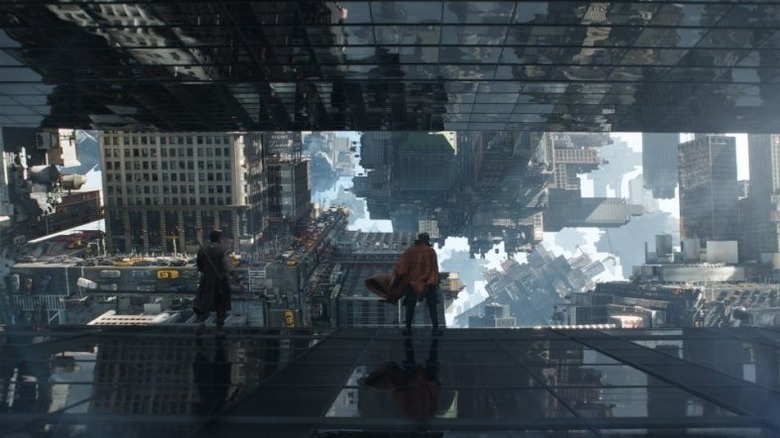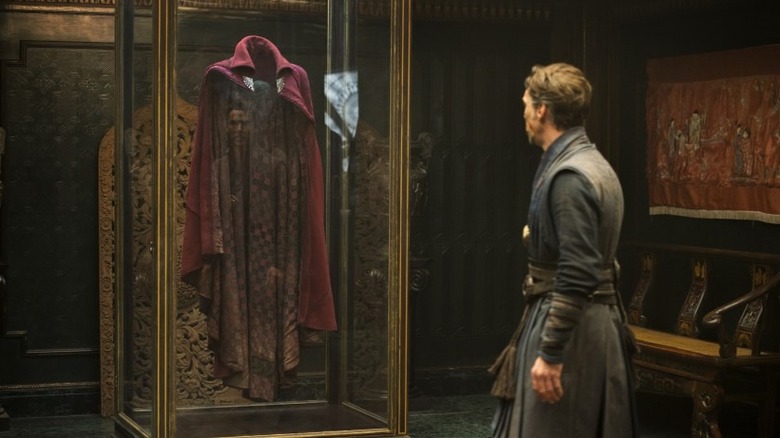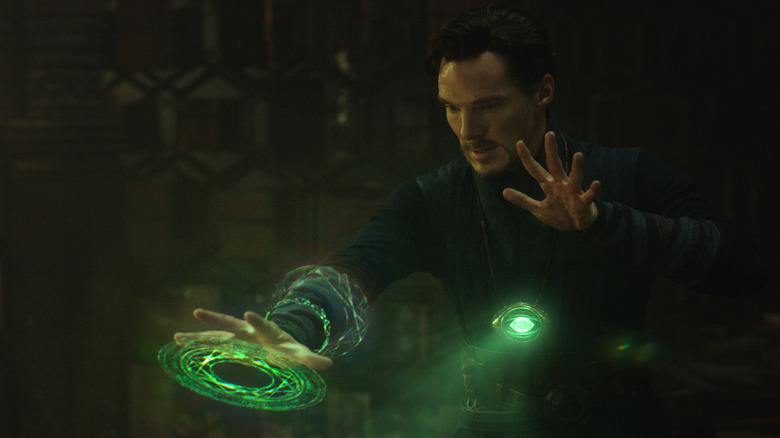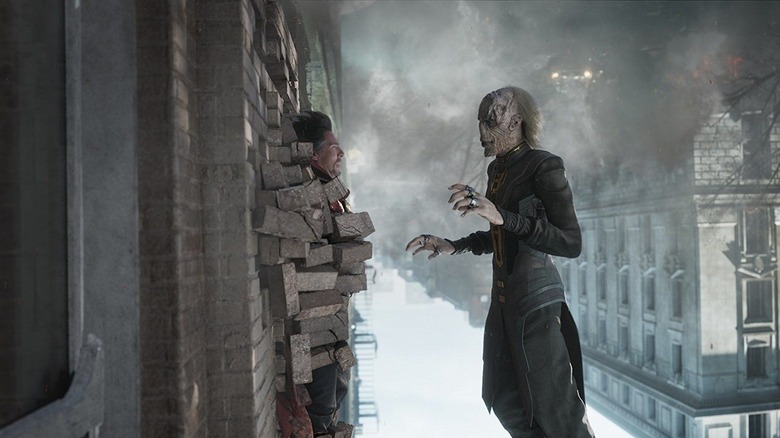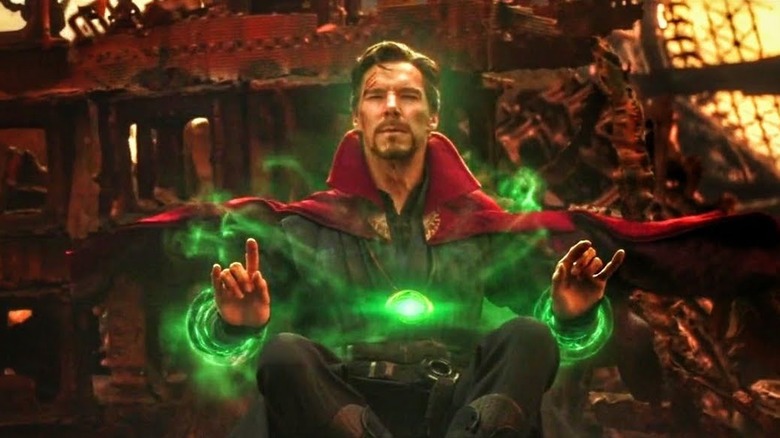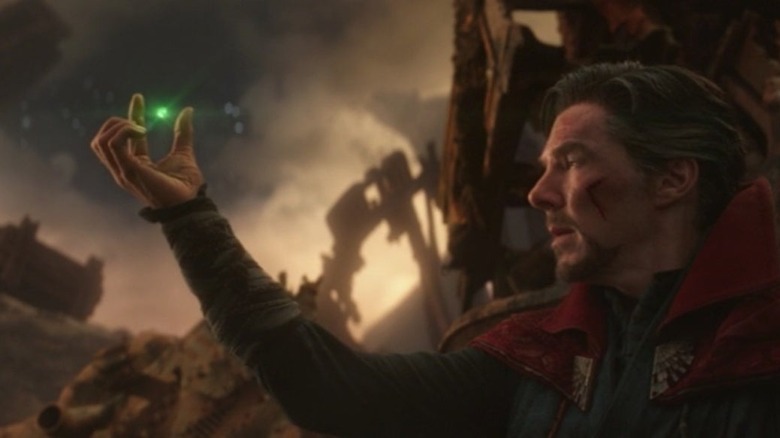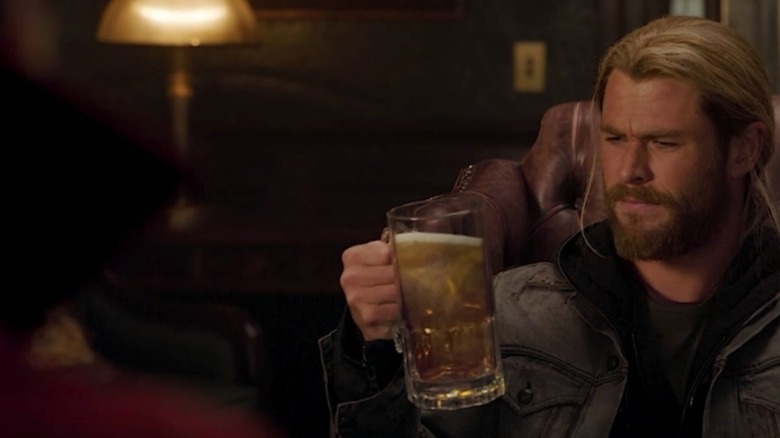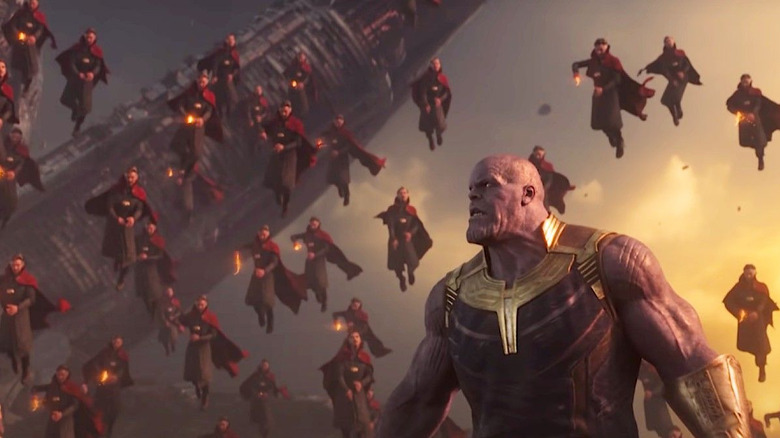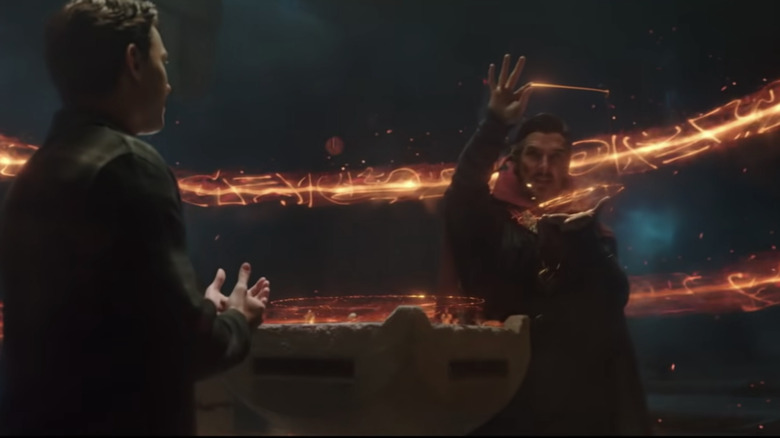All Of Doctor Strange's Powers And Abilities Explained
Doctor Stephen Strange is among the most powerful heroes in the Marvel Cinematic Universe. As the Sorcerer Supreme, he's tasked with safeguarding Earth from magical threats and beings of immense power. Take Dormammu, the big bad from his 2016 eponymous film, "Doctor Strange." Inside his native Dark Dimension, he's a being of uncharted power, capable of absolute mastery of existence within. When Kaecilius (Mads Mikkelsen) summons the Destroyer of Worlds with the missing pages of the Book of Cagliostro, Doctor Strange (Benedict Cumberbatch) is able to defeat him with a bit of trickery and a piece of costume jewelry.
Alright, in fairness, that was actually the Eye of Agamotto, which contains the Time Stone, but perhaps that is better way of making the point. Strange, a mere mortal with only months worth of magical training, is able to wield an Infinity Stone in order to defeat an extra-dimensional, god-tier being. Peter Quill, aka Star-Lord (Chris Pratt), is part Celestial and couldn't wield the Power Stone unaided, relying on Gamora (Zoe Saldana), Drax (Dave Bautista), and Rocket (Bradley Cooper) to help distribute the burden of its energy.
Like the late Tony Stark (Robert Downey Jr.), aka Iron Man, we've wondered what is Doctor Strange's job exactly, besides making balloon animals? Strange says it's to protect reality, which got us wondering exactly how he's able to take on such a monumental task. After much pondering, we've come up with a list of everything we've seen him do in the MCU. These are all of Doctor Strange's powers and abilities, explained.
Astral projection
One of the first acts of magic to which Stephen Strange bears witness is his astral form being pushed out of his physical body by the Ancient One (Tilda Swinton) at Kamar-Taj . At first, he thinks he's been drugged and asks his host what was in the tea he'd just drank, assuming it was a hallucinogen like the mushroom psilocybin. She assures him it's just tea, with a bit of honey, before taking him on an incredible, mind-bending journey — and subsequently kicking him out on his butt.
During his training, Doctor Strange takes advantage of astral projection to increase his knowledge in a unique form of studying: he reads the ancient tomes at his disposal while his physical form sleeps. He advances so quickly that Mordo (Chiwetel Ejiofor) is surprised at the "litany of spells" he was able to master in order to use the Eye of Agamotto. Strange's explanation is his photographic memory, which enabled him to earn an MD and PhD simultaneously. We're guessing that his mind continuing to work while his body rests had a little bit to do with it as well. Of course, Stephen wasn't just hitting the books in his astral form. He fought one of Kaecilius' disciples in the astral plane at the hospital, popping in and out to give Dr. Christine Palmer (Rachel McAdams) instructions — and scaring the bejeezus out of her — as she worked to save his life.
Somewhere along the way, Wanda Maximioff (Elizabeth Olsen), aka the Scarlet Witch, must have taken a cue from Doctor Strange, because we see her doing the exact same thing — studying in the astral plane — at the end of "WandaVision."
Traveling via portals
One of Stephen Strange's first tasks at Kamar-Taj is to learn to open portals with the use of a Sling Ring. The Sling Ring, when used adeptly, allows one to travel across the world like they're walking through a doorway. But Doctor Strange just can't seem to get it right, insisting his unsteady hands are to blame. At that point, the Ancient One brings out Master Hamir (Topo Wresniwiro), who promptly dispels any notion of Strange's hands being the problem when he effortlessly opens a portal, despite missing his left hand from the wrist down. Strange eventually gets the whole portal thing down when the Ancient One leaves him to die of exposure atop Mount Everest if he's unable to conjure a portal to safety.
Just like astral projection, Strange uses portals to advance his studies of the mystic arts; when librarian Wong (Benedict Wong) refuses to allow him to check out certain books he feels are too advanced, Strange just conjures a portal into the library — which is forbidden — to take them surreptitiously. The crafty old librarian may have been confused for a bit but clearly figured it out eventually, evident in the Ancient One's knowledge of the transgression — seriously, Wong told on him?
These portals serve more purpose than just acting as an instant inter-dimensional Uber, of course. Strange used one to nab Loki (Tom Hiddleston) when he and Thor (Chris Hemsworth) were standing on the sidewalk in New York City in "Thor: Ragnarok."
Shield spells
As seen throughout the MCU, pretty much whenever the masters of the mystic arts are around, adepts are able to use magic-based energy shields to ward off enemy attacks, defending against both mystical and physical assaults. According to the MCU Fandom site, they're referred to as "Tao Mandalas." Wait, what? Breaking that term down etymologically, it references two different concepts from Eastern religions and-or mysticism. In the context of Taoism, "tao" has several meanings, the most relevant is likely "the way"; these teachings come from Lao Tzu (also Laozi), the ancient Chinese philosopher to whom the Tao Te Ching is traditionally attributed (via the Stanford Encyclopedia of Philosophy). Though it's not particularly helpful for our task of analyzing the meaning of the shield's name, "tao" is impossible to conceptualize in abstract and is something that must be experienced as the flow of life.
As for "mandala," it's not just a beautiful geometric design from an adult coloring book; as the Merriam-Webster Dictionary tells us, it is "a Hindu or Buddhist graphic symbol of the universe." Combining those two elements suggests that, essentially, Doctor Strange and his fellow mystics are channeling magical energy flowing throughout the universe into shield forms.
As first seen in 2016's "Doctor Strange," Stephen Strange's shields are mostly reactionary; when fending off Kaecilius and his followers, his Tao Mandalas are practically instinctual. Director Scott Derrickson told Vulture they brought on a special choreographer to teach the actors the art of tutting. "I wanted it to be in the action, I wanted it to be more organic, and that seemed to lead me to this idea that magic is about movements and gestures."
Weapon spells
Obviously Stephen Strange is able to use magic for more than just defense. This isn't Daniel LaRusso's vision of Miyagi-do karate, after all; we're talking about dealing with cosmic threats to the balance of the universe, not butting heads with the rival Cobra Kai dojo. One of the earliest weapons we see the title character use in "Doctor Strange" is referred to as the Eldritch Whip, as "Doctor Strange" visual effects supervisor Stephane Ceretti told 3D-World in 2016. "It looks like a stream of energy with lots of sparks, and when it hits something it sears and burns," he said.
We're hoping the "whip" part of that term is pretty self-explanatory and anyone who's dipped even a fraction of a toe into the works of H.P. Lovecraft should recognize "eldritch" as a word meaning strange, unnatural and otherworldly. Unlike the most rudimentary forms of the Tao Mandalas, the Eldritch Whip — which also requires the Sling Ring — looks like takes a bit more practice and concentration to pull off, which is probably a good thing; there's no sense knowing how to attack someone or something without knowing how to defend against a counterattack.
Remember the choreographer we mentioned when discussing shields? "We hired him to do all the choreography, so he taught Tilda and Benedict and Mads. It's very specific and very deliberate and super-cool," director Scott Derrickson told Vulture. "In fact, he's in the movie. He's the very first guy in the opening scene, who forms the magic whip ... It was all very detailed and designed and he was awesome. I'm really glad we used him."
Interdimensional travel
As he grew more adept in his magical abilities, Stephen Strange needed somewhere safe to practice his spell casting. As such, the Ancient One showed him how to enter the Mirror Dimension. It's a parallel plane of existence that looks much like our own but anything Doctor Strange does while there will not affect the physical world. "Harry Potter" fans can think of it as an infinite Room of Requirement for Dumbledore's Army to learn Defense Against the Dark Arts and "X-Men" fans might liken to the Danger Room, except it's not just limited to a broom closet in a mansion in Westchester, New York.
As the Ancient One explains, it's also a place where masters of the mystic arts can trap other beings, provided the don't have a Sling Ring, which is critical to entering the Mirror Dimension. In the first act of "Doctor Strange," it's where she sends Kaecilius and his fanatics when they steal the page from the Book of Cagliostro that explains how to summon Dormammu. It's also where Stephen Strange tries to send them when they attack the New York sanctum. The problem with that idea is he didn't realize that, in channeling energy from the Dark Dimension, they have grown more powerful in the Mirror Dimension and can fold and bend reality with ease, making it difficult for Strange and Mordo to escape.
The warping of the Mirror Dimension was specifically inspired by a renowned Dutch graphic artist. "The idea became, 'What would a chase scene be like inside an M.C. Escher world?' Not just to present it as an exterior canvas, but to actually be inside of it, in motion," director Scott Derrickson told the L.A. Times.
Levitation
In addition to his ability to cast spells, born out of months of learning and effort, Doctor Strange also gets some additional benefits from his keen fashion choices. While that tuxedo he was planning to wear to the medical conference may have turned heads, he eventually acquired a cloak that could likely snap necks.
As Mordo tells him, eventually he will get to use relics that will grant him powers; they're able to do so because they were imbued with magic too powerful to sustain. Mordo himself is rocking the Vaulting Boots of Valtorr; when Strange asks when his turn will come, his mentor goes full-Ollivander and offers the MCU equivalent of "the wand chooses the wizard." "You're ready when the relic decides you're ready," Mordo says.
Well, the relic in question decided Stephen Strange was ready when Kaecilius was absolutely mopping the floor with him. When Dormammu's disciple was tossing the title character around the New York sanctum like a rag doll, he wasn't exactly concerned with keeping it tidy. One of the many things he smashes was the case containing a red cloak, which Mordo later tells Strange is the Cloak of Levitation. In addition to granting the wearer the namesake ability, the cloak also appears to have a will of its own, which is why it's able to save Strange when Kaecilius knocks him over the rail for what looks like a solid 15-foot drop. It's also how the cloak is able to steer the good doctor away from the battle ax he tries to grab in favor the Crimson Bands of Cyttorak relic which imprisons his enemy.
Time manipulation
Courtesy of another relic, Stephen Strange is able to manipulate time, rewinding events so as to rearrange the timeline and affect the eventual outcome of a given situation. The relic in question is the powerful Eye of Agamotto, created by the first Sorcerer Supreme, Agamotto, who also first established the sanctums that the master of the mystic arts use to safeguard the earth. Whether or not its creator was aware of it, the Eye is powered by the Time Stone — as Wong tells us in "Doctor Strange" — which explains why it's so darn powerful.
After all, how else would Doctor Strange been able to pause and rewind the action on the streets of Hong Kong? It's not like reality is a DVR — though, if it was, the Eye of Agamotto would be one of the world's most amazing universal remotes. In addition to an impressive parlor trick of scrolling through the stages of an apple being eaten and its core decaying — which was simply meant to display what the Eye can do — Strange uses it to trap Dormammu in an infinite loop; though the Devourer of World's exists without the flow of time in the Dark Dimension, when on Earth, he must play by our rules. As such, Strange commits himself to dying infinite deaths in order to force Dormammu to abandon his quest to conquer the Earth.
When Strange surrendered the Time Stone in "Avengers: Infinity War," Thanos used it to wipe out half of all life in the universe before destroying all six Infinity Stones. If Captain America (Chris Evans) truly returned all the alternate Stones in "Avengers: Endgame," then Doctor Strange will seemingly no longer have this ability.
Casting protective spells over objects
With an item as powerful as the Eye of Agamotto — and the Time Stone within it — within his possession, Stephen Strange would surely need to go to some length to make sure it's not taken from him. Although he's plenty powerful, he understands that it's likely someone more powerful will come along to try to take it off his hands. Enter Bruce Banner through the roof of the New York sanctum; he tells Doctor Strange and Wong that Thanos is coming. After explaining who the Mad Titan is — you would think Doctor Strange, who keeps a watchlist of potential threats, would have heard of him — they enlist Tony Stark (Robert Downey Jr.)
After Stark and Strange exchange barbs and debate the merits of destroying the Time Stone vs. protecting it, Ebony Maw and Cull Obsidian render the argument meaningless by dropping in on Greenwich Village in search of it, in turn trashing part of the city. Although Ebony Maw gets the better of Strange and eventually abducts him from Earth aboard Thanos' Q Ship, it's pretty clear he can't access the Time Stone. In fact, when he tries, it burns him; as the good doctor explains, were Ebony Maw to kill him, he'd find removing the spell "troublesome." The simple but unbreakable warding spell Strange put on the Eye of Agamotto is likely the only reason he survives the first act of "Infinity War," as Ebony Maw changes tack and takes the Sorcerer Supreme along for the ride to torture him in the hopes of eventually taking possession of the Time Stone.
Foresight
Another trick Doctor Strange can do, courtesy of the Eye of Agamotto, is look into the future. He's not the first Sorcerer Supreme to do so, mind you. Though she doesn't reference the relic by name, the Ancient One tells the good doctor during their chat in the astral realm that she spent "years peering through time," looking at that exact moment outside the hospital but unable to see past it. She claims to have forestalled "countless terrible futures," one after another, and none of them went further than that exact moment in time. In addition to humanizing her, the scene sets up one of the other abilities granted by the Eye.
While on Titan, with Tony Stark and Peter Parker (Tom Holland), aka Spider-Man, having a confab with the remaining Guardians of the Galaxy, Strange is off in the corner doing his thing. He appears to be meditating, levitating in a yogic position with an aura of green energy surrounding him and the Eye of Agamotto glowing brightly. Mantis (Pom Klementieff) is the first to notice, asking Stark if Strange often does that — not that he'd know. When Strange emerges from his trance, he explains that he went forward in time in order to see every outcome of the upcoming battle — just over 14 million possible futures — of which they only win one.
Much like his ability to manipulate time, Doctor Strange appears to be unable to look forward in time in the MCU's current continuity, absent a relic that contains some version of the Time Stone. Time will tell if he somehow regains those abilities.
Conjuring
It's unclear if Doctor Strange's magical abilities have any respect for scientific principles like the law of conservation of mass or the first law of thermodynamics, because he seems to just pull things out of thin air sometimes. We see it happen in one of the "Doctor Strange" post-credits scenes — later adapted into a scene from "Ragnarok" — when he sits down with Thor to talk about his aforementioned watchlist and his adopted brother Loki's (Tom Hiddleston) place on it. When they sit down in those comfy-looking armchairs, Strange offers the God of Thunder tea; though Thor insists he doesn't drink tea, a cup appears in his hand anyway.
That, however, amounts to nothing more than an impressive parlor trick, akin to pulling rabbits out of hats. Doctor Strange's ability to conjure comes into play in much more dire circumstances during "Infinity War." After using the Eye of Agamotto to glimpse the future and the one possible way in which the forces of good are actually able to stop Thanos, Strange seems to have removed the Time Stone from the locket by the time the Mad Titan snatches it from around his neck, declaring it a fake. In truth, Strange has concealed the Time Stone using magic and only reveals it when Thanos is about to kill Tony Stark. The Bleecker Street Magician conjures the Time Stone after the Battle of Titan, bargaining with Thanos to spare Tony Stark's life, as it was part of the one-in-14 million chance they had to win in the end.
Transmutation
On top of making things appear and disappear, Doctor Strange can change them into something else altogether. That cup of tea he summoned for Thor in the New York sanctum? When the self-proclaimed strongest Avenger informed the good doctor that he doesn't drink tea, the cup magically became a liter of beer, which is much more Thor's speed. He was further amazed — and no doubt pleased — to learn that the mug refilled itself as he emptied it. When Bruce Banner (Mark Ruffalo) crashes through the roof of the sanctum during the first act of "Infinity War," Strange's mystical wardrobe, Cloak of Levitation and all, instantly takes on the form of normal street clothes. Once again, however, this is more along the lines of what we expect from professional illusionists, not the peak powers of the Sorcerer Supreme.
Want to get impressed? Once more in "Infinity War," during the Battle of Titan, Thanos forces Doctor Strange to pull out all of the stops. When the former uses the Infinity Gauntlet to send an actual black hole at the latter, Strange's spell transforms it into a swarm of delicate blue butterflies. We're unsure of the significance of the actual butterflies — though Strange did seemingly see a monarch butterfly in space, courtesy of the trip the Ancient One sent him on during his first solo movie — but we're guessing the act of transmuting a super-dense, all-consuming vortex from which not even light can escape into a bunch of pretty insects is pretty significant in and of itself.
An array of other tricks
Doctor Strange has a few more tricks up his magic sleeves as well. Though each of these is only seen a single time, they're worth at least a passing mention. During the events of "Ragnarok," when Thor is looking for the Allfather, Odin (Anthony Hopkins), Strange plucks a single strand of hair from the God fo Thunder's mighty mane. This act — to which Thor does not take kindly — was for the sake of casting a locator spell that would transport Thor and the still-falling Loki through a portal directly to their father.
Strange also uses a couple of one-off tricks in "Infinity War" — during the Battle of Titan — one of which is a different form of the Crimson Bands of Cyttorak, one more loyal to their use in Marvel comic books. Quite different than the usual mystic energy forms Strange uses as shields and weapons, the Crimson bands of Cyttorak are bright red, setting them apart from the bright yellow-orange color of the Tao Mandalas and Eldritch Whip, respectively. Strange pulled them out during the combined attack, seeking to bind Thanos' right hand to prevent his use of the Infinity Gauntlet. When Iron Man and Spider-Man attempt to get it off his hand, Strange restrains the Mad Titan's left hand.
Having failed to get the gauntlet off his hand, Strange later displays an ability to duplicate himself. Dozens of Doctors Strange attack Thanos with multiple Eldritch Whips. Their combined might was no match for the trademark purple blast of the Power Stone, however, as each of the duplicates was dispatched after Thanos attacked with the Infinity Gauntlet.
The Runes of Kof-Kol
When squeaky little Peter Parker is feeling down on himself for problems he kinda-sorta is responsible for, he seeks supernatural assistance to erase it all in "Spider-Man: No Way Home." Peter hopes Doctor Strange can make everyone on Earth forget he was ever Spider-Man so he can escape his newfound celebrity. For some reason, the former Sorcerer Supreme agrees. While this seems like something Steven normally wouldn't even entertain, he had to so we could get a cameo-packed film out of it.
Stephen and Peter head down to the Sanctum's expectedly drab basement, and orange sparks begin flowing. Doctor Strange performs The Runes of Kof-Kal — a spell that would fulfill Peter's exact aforementioned specifications. To put it simply, the Runes wipe the memory of those specified in the spell for a set period of time. According to Wong, the Runes of Kof-Kal travel "the dark borders between known and unknown realities." This initial warning should have made it a no-go, but arrogant Stephen gives it a whirl. The sorcerer didn't account for how annoying Mr. Parker could be, as the latter kept chiming in during the spell, changing his request. He doesn't want those closest to him — MJ, Ned, Happy, Aunt May — to forget his identity. Peter's interruption of the spell mid-progress allows people from other realities to crossover into ours. This only goes for people who know who Peter is, having the somewhat opposite intention of what the Runes of Kof-Kal are meant. Therefore, we get multiple villains from former Spidey flicks crossing over into the MCU, as well as two other Web-Slingers.
Since most of "Spider-Man: No Way Home" is a result of a botched initial Kof-Kal attempt, its finale sees Strange complete it correctly. The rules apply to everyone this time, including Ned, MJ, and Happy, and the film concludes with their memories Peter-wiped as well as everyone else on Earth. The Runes of Kof-Kal also send the reality trespassers back to their respective universes. The villains fade away reformed, while Tobey Maguire and Andrew Garfield's Spideys head back to their realities.
